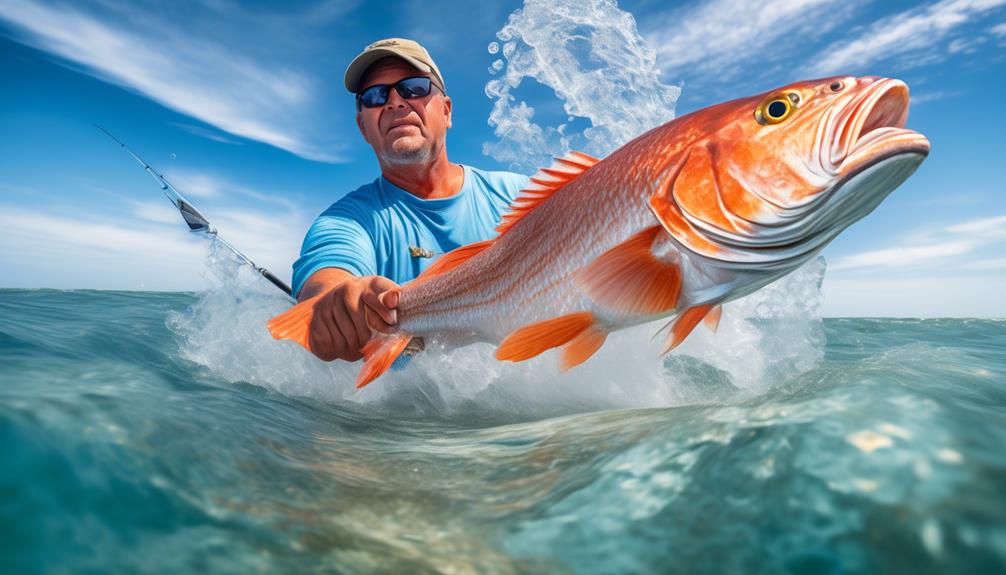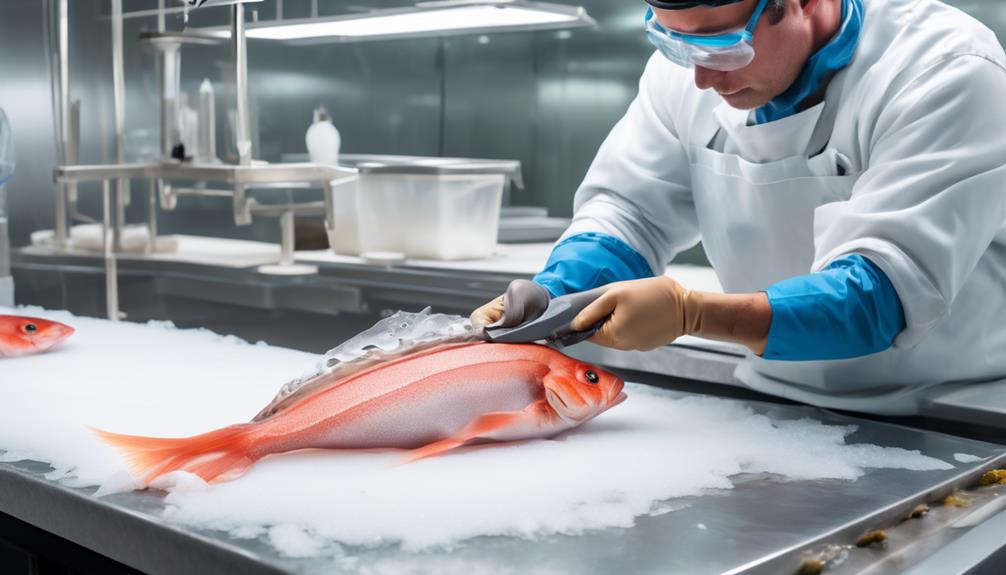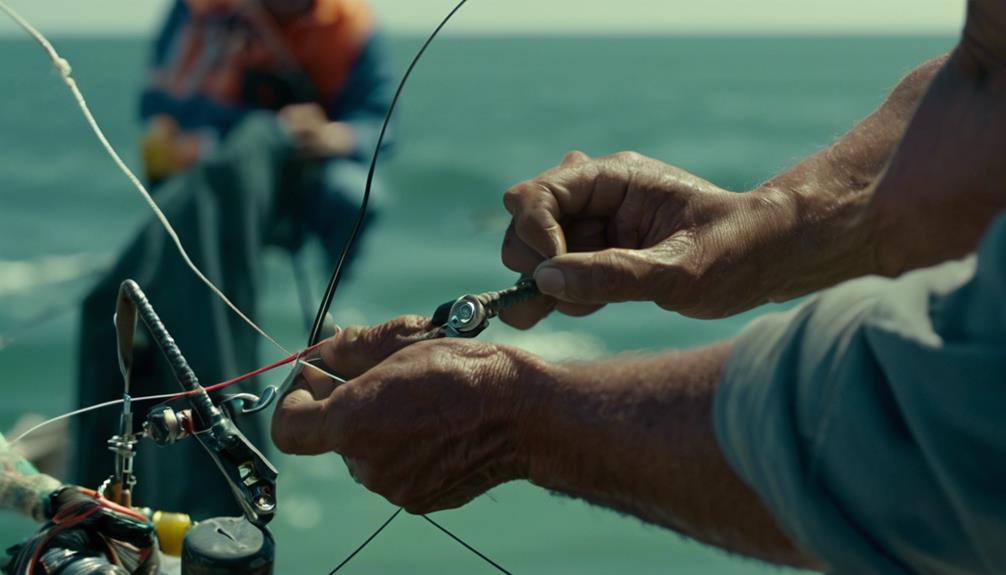You might think that catch and release fishing is just about letting the fish go, but there's a lot more to it than that.
If you want to ensure the fish you release have the best chance of survival, there are essential tips and techniques to keep in mind.
Whether you're a seasoned angler or just starting out, these tips will help you become a more responsible and conservation-minded fisherman.
So, let's dive into the details and discover what it takes to master the art of catch and release saltwater fishing.
Proper Handling Techniques
When handling your catch, gently grasp the fish around the body to avoid injuring it further. Fish safety is paramount, and by handling the fish properly, you can minimize stress and potential harm to the fish. As part of release education, it's crucial to understand the significance of proper handling techniques to ensure the fish's well-being after it's been caught.
To safely handle a fish, wet your hands before touching it. This helps protect the fish's delicate skin and scales. Additionally, avoid touching the fish's gills or eyes, as these are sensitive areas that can easily be injured. By being mindful of these fish safety practices, you can contribute to the successful release of the fish back into its natural habitat.
Another important aspect of release education is using barbless hooks whenever possible. Barbless hooks are easier to remove, reducing the time it takes to release the fish. This minimizes stress and potential injury to the fish, enhancing its chances of survival after being caught. Furthermore, using proper tools such as pliers or hemostats can facilitate the hook removal process, allowing for a quicker and more efficient release.
Selecting the Right Gear
To ensure successful saltwater fishing, selecting the right gear is essential for maximizing your chances of landing a great catch. Here are some essential tips for selecting the right gear:
- Choose corrosion-resistant equipment: Saltwater is corrosive, and your gear will be constantly exposed to it. Opt for reels, hooks, and other equipment made from materials specifically designed to withstand the harsh saltwater environment. Regular gear maintenance, such as rinsing your gear with freshwater after each use and applying lubrication as needed, can also help prevent corrosion and extend the lifespan of your equipment.
- Consider the environmental impact: When selecting your gear, be mindful of the potential environmental impact. Avoid lead sinkers and opt for environmentally friendly alternatives. Additionally, choose gear that minimizes harm to the fish, such as barbless hooks, which are easier to remove and cause less damage to the fish.
- Invest in high-quality line: Saltwater fish are typically larger and more powerful than their freshwater counterparts, so investing in a high-quality, durable fishing line is crucial. Look for lines specifically designed for saltwater fishing, as they're formulated to withstand the extra strain and resist abrasion from saltwater and rough underwater structures.
- Select the right rod and reel combo: Choose a rod and reel combo designed for saltwater fishing, taking into account the specific type of fish you'll be targeting. A well-matched combo will provide the strength and control needed to reel in even the toughest saltwater species.
Understanding Fish Behavior
Understanding fish behavior is crucial in saltwater fishing as it allows you to anticipate their movements and adapt your techniques for a more successful catch. When it comes to fish feeding, it's essential to recognize the times of day when fish are most active. Many saltwater species are known to feed actively during low light conditions, such as dawn and dusk, making these prime times for fishing. Understanding the types of prey fish feed on can also help you select the right bait or lures to attract them.
Migration patterns are another important aspect of fish behavior to consider. Different species of fish have distinct migration routes and habits. Understanding these patterns can significantly increase your chances of a successful catch. For example, during certain times of the year, some species migrate closer to shore, while others move further offshore. By knowing these patterns, you can plan your fishing trips accordingly.
Additionally, learning about the specific behavior of the fish you're targeting can make a big difference. Some species are more likely to be found near certain underwater structures, while others prefer open water. By understanding these preferences, you can focus your efforts on areas where the fish are more likely to be present.
Hook Removal Methods
You can effectively remove a hook from a fish by using the proper techniques and tools. It's essential to prioritize safe handling to ensure the well-being of both the fish and yourself.
Here are some tips for hook removal:
- Use Proper Tools: Always carry long-nose pliers or hemostats to safely remove the hook. These tools allow you to maintain a good grip on the hook for easy extraction without causing additional harm to the fish.
- Minimize Handling: Limit the amount of time the fish is out of the water and avoid excessive handling. Wet your hands before touching the fish to prevent damaging its protective mucus layer, which helps ward off infections.
- Barbless Hooks: Consider using barbless hooks, which can make the removal process much easier and less traumatic for the fish. If you're using barbed hooks, flatten the barb with pliers before fishing to make hook removal gentler.
- Gentle Approach: When removing the hook, be gentle and patient. Avoid forcing the hook out quickly, as this can cause injury. Instead, carefully and slowly back the hook out in the same direction it entered.
Best Practices for Reviving Fish
After safely removing the hook from a fish, it's important to understand the best practices for reviving the fish to ensure its successful release back into the water. Fish resuscitation techniques are crucial for reviving exhausted fish and increasing their chances of survival after being caught.
When a fish appears lethargic or exhausted after being caught, it's essential to handle it with care and take the necessary steps to aid its recovery before releasing it back into the water.
To revive an exhausted fish, hold it upright in the water, allowing it to regain its strength. Gently move the fish back and forth to help water flow through its gills, which aids in oxygenating its blood. If the fish struggles to swim away, support it in an upright position until it can swim off on its own. Avoid releasing the fish until it shows signs of alertness and the ability to swim steadily.
Additionally, if the fish has been out of the water for an extended period, consider using fish resuscitation techniques, such as gently massaging its sides to stimulate blood flow and promote recovery.
Importance of Proper Release
Proper release of a fish back into the water is crucial for its survival and the health of the ecosystem. When you're preparing to release a fish, it's important to consider its behavior and the environmental impact of catch and release.
Here are some essential tips for ensuring the proper release of a fish:
- Release Preparation: Before releasing the fish, ensure that your hands are wet. Dry hands can remove the protective slime layer of the fish, making it more susceptible to infections. Keep the fish in the water as much as possible, and if you need to handle it, support its body properly to minimize stress.
- Fish Behavior: Pay attention to how the fish reacts once it's back in the water. If it needs a moment to recover, gently hold it in the water, moving it back and forth to help water flow through its gills. Once the fish shows signs of readiness, release it gently, allowing it to swim away on its own.
- Environmental Impact: Properly releasing a fish contributes to the sustainability of the marine environment. By allowing the fish to survive and potentially reproduce, you're helping to maintain the balance of the ecosystem and the health of the fish population.
- Catch and Release: Implementing proper release techniques promotes ethical and responsible fishing practices. It allows other anglers to enjoy the thrill of catching the same fish while conserving the marine resources for future generations.
Minimizing Harm During Landing

Minimizing harm during landing begins with understanding the impact of your actions on the fish and the marine environment, ensuring that your approach to catching and handling the fish prioritizes their well-being. Reducing stress on the fish is crucial during the landing process. When landing a fish, it's important to minimize the time it spends out of the water. Quick landing techniques can help achieve this. Avoid playing the fish to exhaustion by using appropriate tackle and maintaining steady pressure to bring the fish in swiftly. The longer the fight, the more stressed and fatigued the fish becomes, making it more susceptible to injury.
Additionally, using barbless hooks can make the unhooking process quicker and easier, reducing the handling time. When handling the fish, wet your hands before touching it to avoid damaging its protective mucous layer, which can lead to infections. Always handle the fish gently and support its body properly to minimize any harm.
If you need to measure or weigh the fish, do so efficiently and have your tools ready before landing it.
Ensuring Ethical Angling Practices
To ensure ethical angling practices, always prioritize the well-being of the fish and the marine environment by following proper handling and release techniques. It's crucial to be mindful of conservation education and ethical fishing practices while enjoying your saltwater fishing experience.
Here are some essential tips to ensure you're practicing ethical angling:
- Stay Informed: Keep yourself updated with the latest guidelines and regulations set by local authorities or conservation organizations. These guidelines are designed to protect fish populations and their habitats.
- Handle Fish with Care: When handling fish, ensure that your hands are wet to protect their delicate protective mucous coating. Avoid touching their gills or eyes, as this can cause harm. Use appropriate tools such as wet gloves or a rubberized net to minimize stress and potential injury to the fish.
- Use Proper Gear: Choose the right gear, such as circle hooks and non-stainless-steel hooks, to reduce injury to the fish. Also, consider using fish-friendly artificial baits and lures that minimize harm.
- Practice Responsible Release: Minimize the time fish are out of the water, especially in hot weather. Use proper release techniques, such as gently reviving the fish by holding it upright in the water until it can swim away on its own.
Frequently Asked Questions
Are There Any Specific Regulations or Guidelines for Catch and Release Fishing in Saltwater?
There are specific regulations and guidelines for catch and release fishing in saltwater to ensure conservation efforts. Understanding fish behavior and using proper handling techniques are best practices to help protect marine life.
How Can I Tell if a Fish Is Stressed or Exhausted After Being Caught and How Can I Properly Revive It?
To properly revive a stressed or exhausted fish, look for signs of stress like sluggish movement or disorientation. Gently support the fish in the water, moving it back and forth to help water flow through its gills for proper revival.
What Are Some Common Mistakes That Anglers Make During the Catch and Release Process That Can Harm the Fish?
When catch and releasing, common mistakes can harm fish. Ensure proper revival for stressed fish. Avoid mishandling, keeping fish out of water too long, and using improper gear. Remember, your actions impact the fish's survival.
Are There Any Specific Types of Lures or Baits That Are Better for Catch and Release Fishing in Saltwater?
When catch and release fishing in saltwater, the best bait to use is natural, such as live shrimp or mullet. Artificial lures like soft plastics with single hooks also work well, minimizing harm to the fish.
What Are Some Alternative Methods for Catching and Releasing Fish in Saltwater That Are Less Harmful to the Fish?
To catch and release fish in saltwater using sustainable practices, consider alternative methods like using circle hooks and barbless hooks. Gentle handling and proper revival techniques are essential for minimizing harm to the fish.
Conclusion
Now that you have learned these essential tips for catch and release saltwater fishing, you can enjoy your fishing experience while also preserving the health and sustainability of the fish population.
By using proper handling techniques, selecting the right gear, and understanding fish behavior, you can ensure a successful and ethical fishing trip.
Remember to always prioritize the well-being of the fish and minimize harm during the catch and release process.
Happy fishing!



